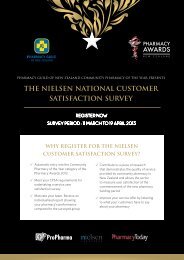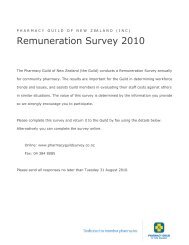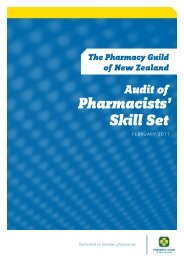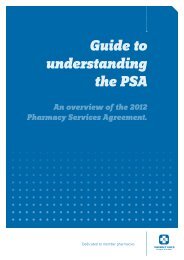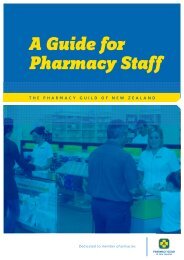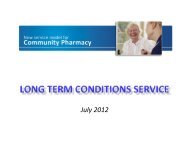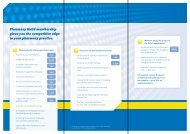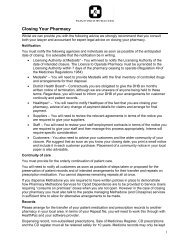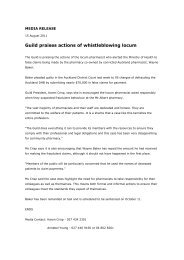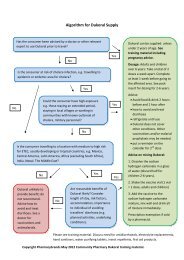Pharmacy Services Agreement 2010 Guide for Guild members
Pharmacy Services Agreement 2010 Guide for Guild members
Pharmacy Services Agreement 2010 Guide for Guild members
- No tags were found...
Create successful ePaper yourself
Turn your PDF publications into a flip-book with our unique Google optimized e-Paper software.
confidential – <strong>for</strong> – <strong>for</strong> guild guild <strong>members</strong> only onlyPayment terms (Schedule H1)This Schedule draws together the payment terms <strong>for</strong> all the services pharmacy provides under the PSA. Pharmacies agreeingto provide additional services under Part P of the Service <strong>Agreement</strong> template may find this also varies Schedule H1.The basis <strong>for</strong> claiming is fee-<strong>for</strong>-service. The basic <strong>for</strong>mula is:Amount claimable =Dispensing Fee + Drug subsidy and margin – Co-paymentYour dispensary software should automatically generate the correct claim amounts <strong>for</strong> each dispensing.Dispensing feeEach prescription item generates a dispensing fee of $5.30 (excluding GST). This dispensing fee is then multiplied by theapplicable multiplier. For most services the multiplier is one. However, more complicated dispensings tend to have highermultipliers to reflect the additional professional input. For example, Monitored Therapy Medicine <strong>Services</strong> has a multiplierof two. There<strong>for</strong>e, each clozapine dispensing generates a dispensing fee of $10.60 ($5.30 x 2), plus GST.Drug subsidy and marginYou are able to claim the subsidy <strong>for</strong> each pharmaceutical that is listed in the Pharmaceutical Schedule. The side letterregarding the date of dispensing definition confirms that the correct subsidy to be claimed is the subsidy that applied asat the date the prescription was presented, not the date the pharmaceuticals were collected.In addition to the subsidy, you are able to claim a mark-up on the subsidy. This mark-up is erroneously referred to as amargin in the <strong>Agreement</strong>. For almost all pharmacies the mark-up is either 4% or 5%.■■ A mark-up of 5% is applied to all products where the subsidy price of the pack listed in the Pharmaceutical Schedule is$150 or greater. It is designed to compensate <strong>for</strong> the additional risks associated with broken packs of slow moving lines.■■ A mark-up of 5% is applied to all products listed as a Special Food in the Pharmaceutical Schedule.■■ For all other products, the mark-up is 4%.Subsidies and mark-ups are all stated as excluding GST.Co-paymentFinally, the claim amount is reduced by the co-payment that was applicable on that item. Note that the co-paymentincludes GST.Regardless of the actual co-payment you collected, the amount the claim is reduced by is the maximum co-payment youcould have collected. This ensures that pharmacies that choose to discount the co-payments they charge bear the cost ofthat discounting, not the DHB.Product Premiums and <strong>Pharmacy</strong> ChargesIn addition to the amounts you may claim from the DHB, which is covered by this schedule, some additional amounts maybe charged directly to the service user. Please refer to clauses H4.5 (Product Premiums) and H4.6 (<strong>Pharmacy</strong> Charges) <strong>for</strong>permissible charges.Also note that you may charge <strong>for</strong> other services you provide to the Service Users that are in excess of the requirements ofthe PSA or the Pharmaceutical Schedule. An example of this might be accepting a credit card payment as a co-payment.Audit framework (Schedule J1)This Schedule provides detail of the audit framework arising from the <strong>Agreement</strong>, in particular specifying the obligations ofthe auditor and the pharmacy, timeframes and a generic process outline.PAGE 33




